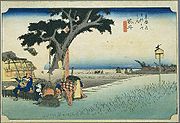
Fukuroi-juku
Encyclopedia

53 Stations of the Tokaido
The are the rest areas along the Tōkaidō, which was a coastal route that ran from Nihonbashi in Edo to Sanjō Ōhashi in Kyoto.-Stations of the Tōkaidō:...
of the Tōkaidō
Tokaido (road)
The ' was the most important of the Five Routes of the Edo period, connecting Edo to Kyoto in Japan. Unlike the inland and less heavily travelled Nakasendō, the Tōkaidō travelled along the sea coast of eastern Honshū, hence the route's name....
, making it the center of the route. It is located in what is now the center of the city of Fukuroi
Fukuroi, Shizuoka
is a city located in Shizuoka, Japan. As of February 2009, the city had an estimated population of 85,985 and a density of 792 persons per km². The total area is 108.56 km².-Geography:...
, Shizuoka Prefecture
Shizuoka Prefecture
is a prefecture of Japan located in the Chūbu region on Honshu island. The capital is the city of Shizuoka.- History :Shizuoka prefecture was formed from the former Tōtōmi, Suruga and Izu provinces.The area was the home of the first Tokugawa Shogun...
, Japan
Japan
Japan is an island nation in East Asia. Located in the Pacific Ocean, it lies to the east of the Sea of Japan, China, North Korea, South Korea and Russia, stretching from the Sea of Okhotsk in the north to the East China Sea and Taiwan in the south...
.
History
Fukuroi-juku was developed later than most of the other post stationsShukuba
were post stations during the Edo period in Japan, generally located on one of the Edo Five Routes or one of its sub-routes. They were also called shukueki . These post stations were places where travelers could rest on their journey around the nation...
, as it was not established until 1616. It is 9.7 km from Kakegawa-juku
Kakegawa-juku
was the twenty-sixth of the fifty-three stations of the Tōkaidō. It is located in the what is now the city of Kakegawa, Shizuoka Prefecture, Japan.-History:Kakegawa-juku was originally the castle town of Kakegawa Castle...
, the preceding post town. At its peak, Fukuroi-juku was home to 195 buildings, including three honjin
Honjin
thumb|250px|The honjin at [[Inaba Kaidō]]'s [[Ōhara-shuku]]. is the Japanese word for an inn for government officials, generally located in post stations during the later part of the Edo period.-Evolution of Honjin:...
and 50 hatago
Hatago
were Edo period lodgings for travelers at shukuba along the national highways, including the Edo Five Routes and the subroutes. In addition to a place to rest, hatago also offered meals and other foods to the travelers...
. Its total population was approximately 843 people.
Because it was in the vicinity of the former Tōtōmi Province
Totomi Province
was a province of Japan in the area of Japan that is today western Shizuoka Prefecture. Tōtōmi bordered on Mikawa, Suruga and Shinano Provinces. Its abbreviated form name was .-History:...
's three major temples, it also flourished as the gateway to the three temples. The three temples were: Hattasan Sonei-ji (法多山尊永寺), Kasuisai (可睡斎) and Yusan-ji (油山寺).
The classic ukiyoe print by Ando Hiroshige (Hoeido edition) from 1831-1834 depicts a couple of travelers sheltering at a wayside lean-to, in front of which a woman stirs a large kettle hung from the branch of a large tree. The area surrounding appear to be desolate rice fields, with little indication of a post town.
Further reading
- Carey, Patrick. Rediscovering the Old Tokaido:In the Footsteps of Hiroshige. Global Books UK (2000). ISBN 1901903109
- Chiba, Reiko. Hiroshige's Tokaido in Prints and Poetry. Tuttle. (1982) ISBN 0804802467
- Taganau, Jilly. The Tokaido Road: Travelling and Representation in Edo and Meiji Japan. RoutledgeCurzon (2004). ISBN 0415310911

